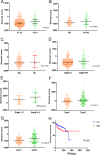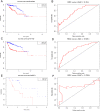Identification of 4-genes model in papillary renal cell tumor microenvironment based on comprehensive analysis
- PMID: 33993869
- PMCID: PMC8127234
- DOI: 10.1186/s12885-021-08319-0
Identification of 4-genes model in papillary renal cell tumor microenvironment based on comprehensive analysis
Abstract
Background: The tumor microenvironment acts a pivotal part in the occurrence and development of tumor. However, there are few studies on the microenvironment of papillary renal cell carcinoma (PRCC). Our study aims to explore prognostic genes related to tumor microenvironment in PRCC.
Methods: PRCC expression profiles and clinical data were extracted from The Cancer Gene Atlas (TCGA) and Gene Expression Omnibus (GEO) database. Immune/stromal scores were performed utilizing the ESTIMATE algorithm. Three hundred fifty-seven samples were split into two groups on the basis of median immune/stromal score, and comparison of gene expression was conducted. Intersect genes were obtained by Venn diagrams. Hub genes were selected through protein-protein interaction (PPI) network construction, and relevant functional analysis was conducted by DAVID. We used Kaplan-Meier analysis to identify the correlations between genes and overall survival (OS) and progression-free survival (PFS). Univariate and multivariate cox regression analysis were employed to construct survival model. Cibersort was used to predict the immune cell composition of high and low risk group. Combined nomograms were built to predict PRCC prognosis. Immune properties of PRCC were validated by The Cancer Immunome Atlas (TCIA).
Results: We found immune/stromal score was correlated with T pathological stages and PRCC subtypes. Nine hundred eighty-nine differentially expressed genes (DEGs) and 1169 DEGs were identified respectively on the basis of immune and stromal score. Venn diagrams indicated that 763 co-upregulated genes and 4 co-downregulated genes were identified. Kaplan-Meier analysis revealed that 120 genes were involved in tumor prognosis. Then PPI network analysis identified 22 hub genes, and four of which were significantly related to OS in patients with PRCC confirmed by cox regression analysis. Finally, we constructed a prognostic nomogram which combined with influence factors.
Conclusions: Four tumor microenvironment-related genes (CD79A, CXCL13, IL6 and CCL19) were identified as biomarkers for PRCC prognosis.
Keywords: Hub genes; Papillary renal cell carcinoma; Prognosis; Tumor microenvironment.
Conflict of interest statement
The authors declare that they have no competing interests.
Figures




Similar articles
-
Identification of potential biomarkers associated with immune infiltration in papillary renal cell carcinoma.J Clin Lab Anal. 2021 Nov;35(11):e24022. doi: 10.1002/jcla.24022. Epub 2021 Oct 4. J Clin Lab Anal. 2021. PMID: 34606125 Free PMC article.
-
Three-gene risk model in papillary renal cell carcinoma: a robust likelihood-based survival analysis.Aging (Albany NY). 2020 Nov 5;12(21):21854-21873. doi: 10.18632/aging.104001. Epub 2020 Nov 5. Aging (Albany NY). 2020. PMID: 33154194 Free PMC article.
-
Association of CXCL13 and Immune Cell Infiltration Signature in Clear Cell Renal Cell Carcinoma.Int J Med Sci. 2020 Jun 27;17(11):1610-1624. doi: 10.7150/ijms.46874. eCollection 2020. Int J Med Sci. 2020. PMID: 32669964 Free PMC article.
-
Roles of the Dynamic Tumor Immune Microenvironment in the Individualized Treatment of Advanced Clear Cell Renal Cell Carcinoma.Front Immunol. 2021 Mar 4;12:653358. doi: 10.3389/fimmu.2021.653358. eCollection 2021. Front Immunol. 2021. PMID: 33746989 Free PMC article. Review.
-
Contemporary review of papillary renal cell carcinoma-current state and future directions.Virchows Arch. 2024 Sep;485(3):391-405. doi: 10.1007/s00428-024-03865-x. Epub 2024 Jul 12. Virchows Arch. 2024. PMID: 38995356 Review.
Cited by
-
Dephosphorylation-related signature predicts the prognosis of papillary renal cell carcinoma.Transl Cancer Res. 2024 Nov 30;13(11):5983-5994. doi: 10.21037/tcr-24-669. Epub 2024 Nov 25. Transl Cancer Res. 2024. PMID: 39697703 Free PMC article.
-
N-acetyltransferase 10 as a novel prognostic biomarker in papillary renal cell carcinoma: a machine learning and experimental validation study.Transl Cancer Res. 2024 Nov 30;13(11):6364-6380. doi: 10.21037/tcr-2024-2195. Epub 2024 Nov 27. Transl Cancer Res. 2024. PMID: 39697710 Free PMC article.
-
A Novel Ferroptosis-Related lncRNA Signature for Prognosis Prediction in Patients with Papillary Renal Cell Carcinoma.Int J Gen Med. 2022 Jan 6;15:207-222. doi: 10.2147/IJGM.S341034. eCollection 2022. Int J Gen Med. 2022. PMID: 35023959 Free PMC article.
-
Comprehensive analyses of immune tumor microenvironment in papillary renal cell carcinoma.J Immunother Cancer. 2023 Nov;11(11):e006885. doi: 10.1136/jitc-2023-006885. J Immunother Cancer. 2023. PMID: 37935564 Free PMC article.
-
[Correlations of immune cell infiltration characteristics with clinicopathological parameters in patients with clear cell renal cell carcinoma].Nan Fang Yi Ke Da Xue Xue Bao. 2025 Jun 20;45(6):1280-1288. doi: 10.12122/j.issn.1673-4254.2025.06.17. Nan Fang Yi Ke Da Xue Xue Bao. 2025. PMID: 40579141 Free PMC article. Chinese.
References
-
- Sung H, Ferlay J, Siegel RL, Laversanne M, Soerjomataram I, Jemal A, Bray F. Global Cancer Statistics 2020: GLOBOCAN Estimates of Incidence and Mortality Worldwide for 36 Cancers in 185 Countries. CA Cancer J Clin. 2021;71(3):209–49. 10.3322/caac.21660. - PubMed
-
- Vrdoljak E, Ciuleanu T, Kharkevich G, Mardiak J, Mego M, Padrik P, Petruzelka L, Purkalne G, Shparyk Y, Skrbinc B, et al. Optimizing treatment for patients with metastatic renal cell carcinoma in the central and eastern European region. Expert Opin Pharmacother. 2012;13(2):159–174. doi: 10.1517/14656566.2012.647406. - DOI - PubMed
MeSH terms
Substances
LinkOut - more resources
Full Text Sources
Other Literature Sources
Medical
Miscellaneous

